New dungeon crawl board game: Super Fantasy: Ugly Snouts Assault
|
This post was updated on .
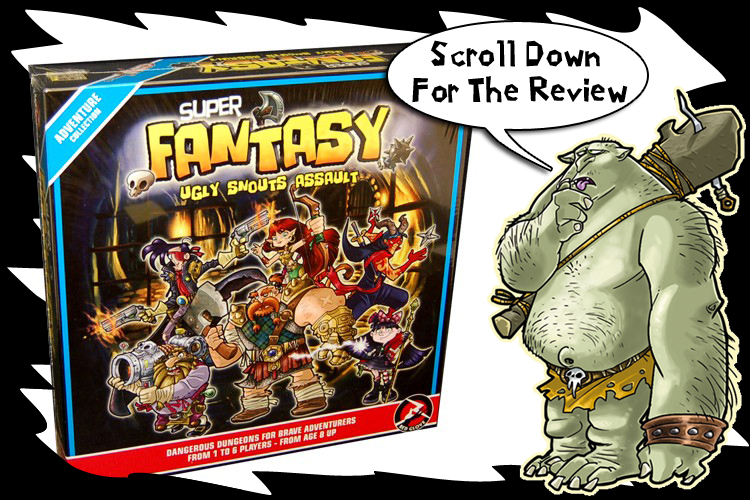 Saw a great review for it on the dice tower. I ordered mine and it should be in tonight. Fully co-op, supports solo play. I'll let you know what I think. It has some really cool mechanics that I haven't seen in a dungeon crawl before. I like cartoon art, but the art in this game is a bit too much. Willing to put up with it if it's as fun as it looks. |
Re: New dungeon crawl board game: Super Fantasy: Ugly Snouts Assault
|
Administrator
|
I look forward to seeing more
-----------------------------------
~The ravings of a single mad Goblin is bad enough, but such a power-hungry, malice-filled creature as Mortis can never hope to be understood~ |
|
In reply to this post by bschummer
*** WARNING ***: This game is originally from Italy and the English instructions have been HORRIBLY translated. I hope that this review along with the great Dice Tower review will be enough to help some people understand it's bizarre wordings for some of the game play elements.
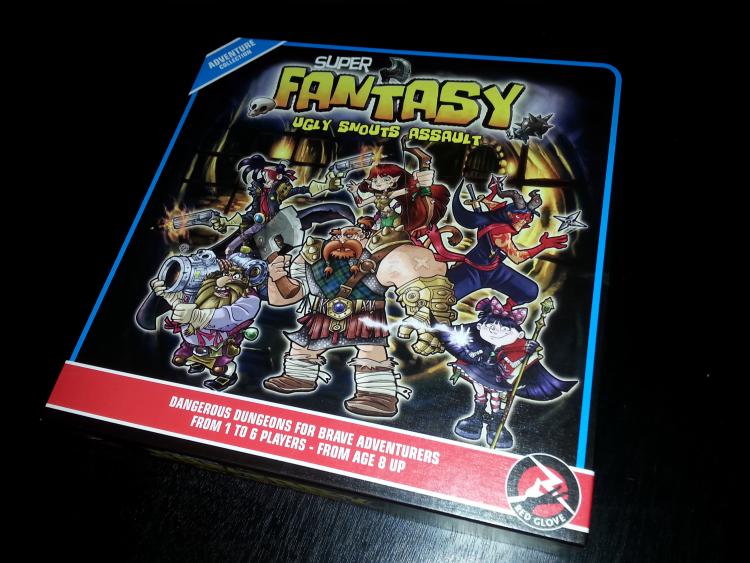 Super Fantasy is an interesting new dungeon crawl from Italy with a colorful cartoon look and feel. It's fully cooperative and supports solo play, which is almost essential for me since getting time for a game group is pretty difficult these days. There are a lot of things about the game that may be deal breakers for some dungeon crawl enthusiasts (the overly cartoon-y art may put some off entirely, for example), but the game uses a lot of interesting mechanics not found in other dungeon crawls, and these mechanics easily make the game worth checking out. THE COMPONENTS 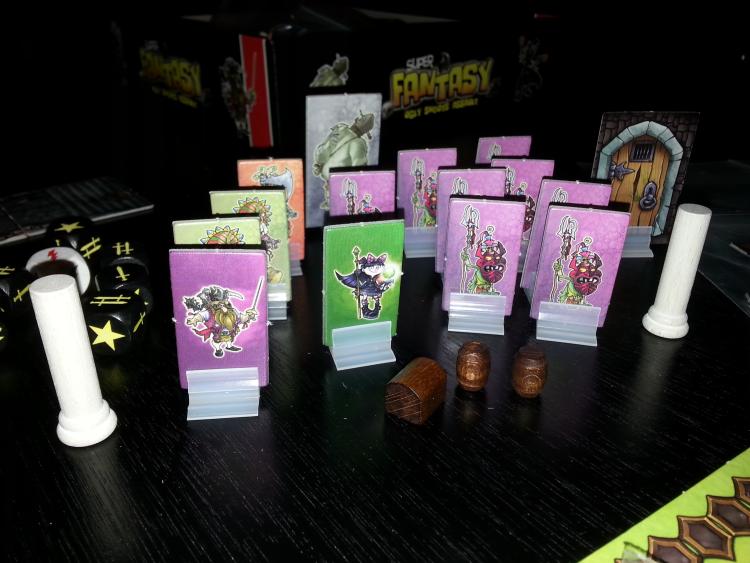 So if the cartoon art didn't scare you away, this might. No minis in this game, just cardboard standees. The backs of the standees are silhouettes so you know which way they are facing (yes, there is facing, more later). However the standees do keep the game less expensive than other dungeon crawls on the market ($49.99 msrp in the US). Also on the plus side, there are lots of wooden bits for barrels, which you can break open to find stuff, and treasure chests, which can be picked open for magical items to equip your character. Also some 3D wood columns and plenty of cardboard doors. The dice are wooden, as well. Speaking of dice, there are 7 dice in the game: 6 black dice representing each players resources, and one "fate" die, to determine random events in the game. The game is played on modular dungeon tiles, with no puzzle piece connections. This makes them highly customizable, although some depict walls which block movement. The art is really well done and fits the cartoon theme. I would have preferred thicker cardboard similar to the D&D Adventure System games, but these should still hold up just fine. If you're still with me so far, I'll tell you how it's played. STARTING THE GAME The game is scenario driven and comes with a book of scenarios to choose from. When you choose a scenario, you must leave the book open for reference, because it has information on monster stats and "fate" die events. I'll be playing scenario one in solo mode. The game has a range of difficulty (easy, medium, hard), and the amount of reinforcements that can spawn on the board is determined by the amount of heroes. In solo mode, the game tells you which heroes you should use for the chosen adventure, and that for game purposes the number of players should be considered these heroes, plus 1. So in a solo game with two heroes, the number of players is considered 3. This is bizarre, and I'm not sure why they decided to add that extra difficulty. In a 2 player game, each player chooses one hero and the amount of heroes is simply considered two. It seems that the solo player is being additionally challenged for no apparent reason. Anyway, the adventure suggests running the Dwarf and the Enchantress, so I get their cardboard standees, player cards, and all level up spells associated with them. And some wood bits to track experience. 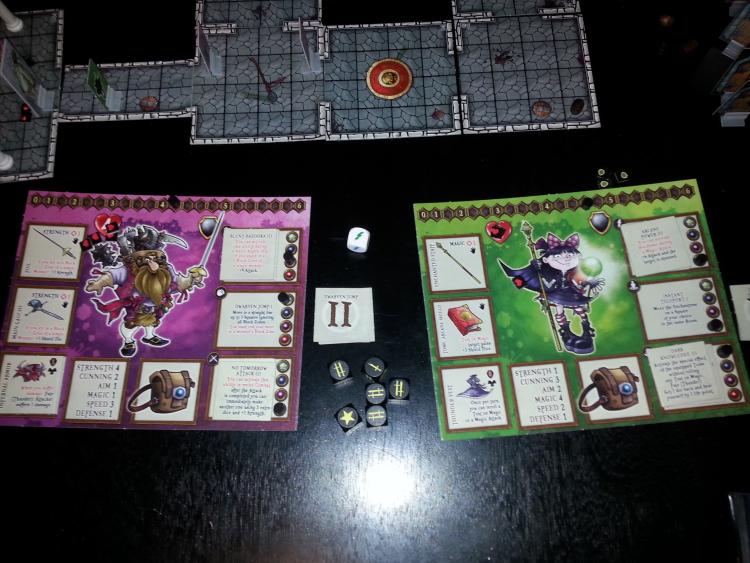 I'll get to the specifics of game play in a moment, but while we are looking at the boards I'll let you know how magic and experience works. Every time you do damage to a monster, successfully pick a door lock or treasure chest, you move your experience up by one space. Once you reach a new number, you can upgrade a spell. Each spell has three levels. Level one is printed on the board. When you upgrade to level two, you put the level two card over the level one spell, and it takes effect. When you get to the next level number, you may upgrade that spell to level three, or upgrade another one to level two, and so on throughout the adventure. To cast a spell, it needs to be charged up to full. This can happen in two different ways. On your turn, you can use dice to attempt to "charge" your magic. If successful (more on success later), you can move the wooden token on one spell up one space. Also, and this is more common, you may charge a spell whenever you roll a STAR on the dice whenever you attempt something on your turn, whether moving, attacking, opening doors, etc. Once the spell is fully charged, you may use it's effect during your turn, and move the wooden token back to the bottom so it can charge again. SCENARIO ONE: GAME PLAY 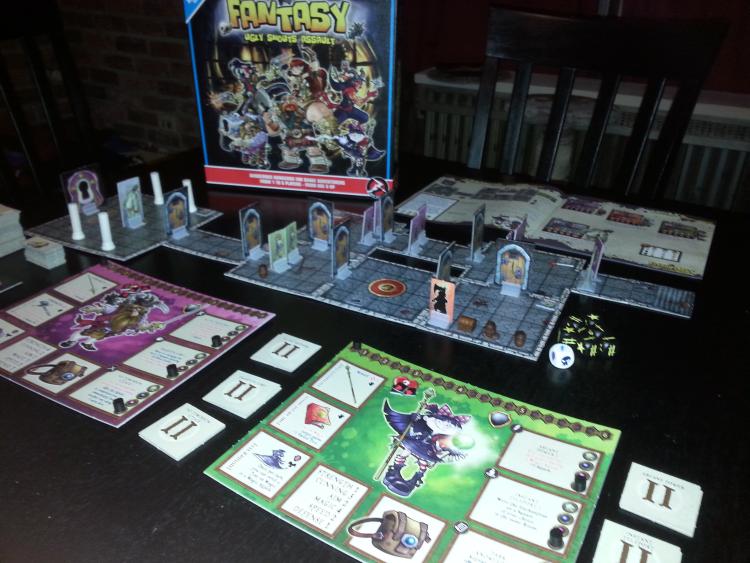 In this scenario, the heroes must get from the start of the dungeon to the end, and successfully jump through the magic portal that awaits. On their way they will find plenty of SNOUTS (monsters) trying to thwart them. The game is played in rounds, and the selected scenario tells you how many rounds you have to complete your mission. The game includes a round "timer"; a cardboard square with tokens for keeping track of game play. You put a sword token at the start, and put a red skull token on the end of the timer. At the start of each new round, you move the sword token one space forward. If ever the sword and skull meet on the timer, then time is up for the heroes and they have failed the adventure! Each round sees the heroes take their turns, then all the monsters activate. The rules states that the heroes may choose which order they go in on each round, so strategy and table talk is certainly encouraged. Game Mechanics (This is where it gets interesting) The Hero Phase Every hero has a dice pool containing the 6 wooden dice previously mentioned. On a hero's turn they can do allocate as many dice as they want to attempt the following actions: - Move - Attack - Open a door (pick the lock or smash it) - Pick the lock on a treasure chest - Smash a barrel - Charge magic - Prepare to defend themselves A hero can do as many of these actions as long as he or she has the dice to do so. Once a die is spent, it can't be used again on this turn. When a hero rolls the dice, they count the amount of successes. One sword equals one success, two swords is two successes, and if they roll a STAR, they get to use the number on their stat block for whichever skill they were rolling for. So if the Dwarf wants to move into the room and get closer to those SNOUTS, he can roll one die. On a one or a two, he moves one or two spaces, respectively. But if he rolls a STAR, he can move his speed value, which in his case is 3. Now that he is closer, he can choose to attack. He declares which weapon he is attacking with, applies any bonuses it might have, then chooses an amount of dice to roll (he only has five left). Since the Ugly SNOUTS have only 4 defense, he rolls two dice, hoping to get some STARs which will let him use his strength of 4. But he only rolls two swords! The attack fails and the dice are lost! But he tries again, rolling two more dice. Two STARs, giving him 8 attack points! Since 8 is greater than the SNOUT's defense of 4, he does one damage! One damage is all it takes for this particular monster, and the SNOUT is removed from the board. With only one die left in his pool, the Dwarf can choose to either attack again the next monster he is adjacent to, but the only way to damage him will be to roll a STAR. Being more cautious, the Dwarf chooses instead to save the dice for defense. At the end of his turn, he gets 1 shield token for every dice that he saved for defense (in this case one), and the dice pool passes to the next player. And since he wounded an enemy, he gains 1 experience point, taking him from level 0 to level 1, and he can upgrade any one spell he controls to Level II. The Enchantress is up next, and she uses magic attacks which have a range of 2. She is at least three squares away from any SNOUTs, so she spends one die to move. She rolls a star, which lets her charge a magic power by one and move her speed, which is 2. She moves by the closest door, which is two squares away from the nearest enemy, and spends two dice to attack with her magic staff. She only gets three successes, but she is wearing enchanted armor that offers no defense, but once per turn it lets her re-roll any magic attack or check. Perfect! She rolls again, getting a STAR and two successes. Since the magic staff uses MAGIC to attack, and her MAGIC stat is 4, she has 6 attack, and destroys the creature! With three dice left, she attempts to pick the lock of the door, which requires a successful CUNNING check. When a hero makes a check, they need six successes to accomplish their task. She rolls 4 successes and a STAR, which gives her 7, and the door lock is picked! Since the Enchantress rolled a total of three STARs on her turn, she has charged her magic attack 3 times, and is only one step away from fully charged! Since she destroyed an enemy and picked the lock on a door, she gains 2 experience points, taking her to Level 1 as well, and she upgrades her magic attack to Level II. It's important to note that the charge of her magic attack stays the same when it is upgraded, so she still only needs one more charge to unleash her new Level II power! The Monster Phase At the start of the game, most rooms in the dungeon are "asleep". That means the monsters in them are unprepared and will not be activated. At the start of the monster phase, the players must find out which monsters wake up. Any room that the players have entered will automatically wake up, so the sleep token in the first room is removed. If the heroes damaged any SNOUTs in the hero phase (which they did), they must then check if the adjacent rooms heard the noise and wake up. This is done with the FATE die. The heroes roll the FATE die and if the symbol on the die matches the symbol of any monster in the adjacent rooms, those rooms wake up. In the first scenario, the symbol for every monster is a lightning bolt (the most common symbol on the die). But I manage to roll the water drop symbol, so the adjacent rooms do nothing this turn. Next we have to check if reinforcements show up. There are several spawn points on the board, and these points cannot be destroyed. For each spawn point, you roll the FATE die and compare the symbol to the chart in the adventure book. This will tell you how many reinforcements to place on the board. Reinforcements are always basic Ugly SNOUTs, the lowest level enemy in the game. Different amounts of Ugly SNOUTs will spawn depending on how many heroes are playing the game. If an enemy spawns in a room that is "asleep", then that enemy is also considered "asleep" and will not activate this turn. There are five spawn points in scenario one, a big one in the center that can hold four enemies, and four small spawn points in the final room that can hold one enemy each. If a spawn point is full or if there are no more Ugly SNOUTs available to put out, then nothing spawns in that space. Now the enemies activate, and it gets a little odd. The enemies have little to no AI. They do have guidelines on who they like to attack first, but the rules ask the players to be very strategic when activating enemies. If you have ever set up a game of Descent (or HeroQuest, Doom: The Boardgame, Space Hulk, etc) and tried to play both sides, this is exactly how that feels. That's not really a bad thing, but I prefer a solo or co-op game to have a better, more rigid enemy AI, like the D&D Adventure System games, or Fantasy Flight's Gears of War game. But anyway, the enemies have stats and special abilities, all specific to the adventure you have chosen. So they move a certain distance, attack with a certain amount of dice, and so on. When the remaining SNOUT attacks the Dwarf, the SNOUT rolls two dice, getting 3 successes. The Dwarf cashes in his shield token to roll one die, but the maximum he could get is 2, so he loses one life point. If a hero ever reaches zero life points and dies, they are not out of the game! Instead the red skull on the round timer gets moved one space closer to start. This means the heroes have less time to reach their goal. In the meantime the hero lays down their standee so no more monsters can attack this round, and at the start of the next round they stand back up and recover all of their life points. The game continues in this way, each round bringing you closer to the red skull, so you really need to plan your turns effectively. Along the way you can smash barrels and get small items, and you can carry up to two of them at a time in your backpack. Small items are consumables that give you boons such as regaining life points or re-rolling dice. You can also pick locks on treasure chests which give you magic items; new weapons and armor to outfit your hero, or pass on to your friends. There are many more intricacies to the rules, involving facing (which is important for some magic attacks and special items), enemy "block zones", enemy movement through doors, etc. But by now you should get the basics of the game, and the poorly translated rule book will cover all the rest. FINAL THOUGHTS Super Fantasy is a fun, unique dungeon crawl experience. The use of a dice pool really does let you feel free to do several things on your turn, and can add a "push your luck" mechanic to the game. The rewards for leveling up can be felt early in the game and continue throughout play, which adds a great deal of excitement to the adventure. The timed mechanic adds the needed pressure to get in and get done, or else! The game is not without its flaws, of course. There are not many different enemy types in the game, and reinforcements are always going to be the lowly Ugly SNOUTs, which can be predictable. The need to reference the adventure book for monster stats is somewhat annoying. Monster stats change from one adventure to the next, so memorizing stats and abilities is less than useful. This changing stat block may also make it challenging to come up with your own adventures once you have exhausted the ones that are included. If you have never like dungeon crawl board games, this one will probably not change your mind, despite the interesting mechanics. However, If you do like a good old monster fighting, chest looting, dungeon delving adventure, then you should certainly give Super Fantasy a try. There is a lot of fun to be had, and plenty of SNOUTs to smash! |
Re: New dungeon crawl board game: Super Fantasy: Ugly Snouts Assault
|
Administrator
|
Excellent - Nice to see someone else posting reviews here!
Most of the time when I buy a game, it will be one that contains miniatures that I can use in other games so that even if I don't ever play the game I've still got something out of it. So for that reason I probably wouldn't buy this game - The wooden bits are nice, but firmly on the side of being board-game components rather than miniatures. I think perhaps I would like to see a future edition of this game which included miniatures, perhaps stylised ones like the ones from the strangely similarly titled 'Super Dungeon Explore' but Chibi, Bobble-head and/or Manga style miniatures aren’t really my thing. Talking of Super Dungeon Explore I'd be interested to know how Super Fantasy compares rules wise to Super Dungeon Explore as from the box cover alone it would appear to be some what of a copy-cat game. I've never played SDE but I'd like to get hold of a few of their chest/mimic miniatures for my own games. 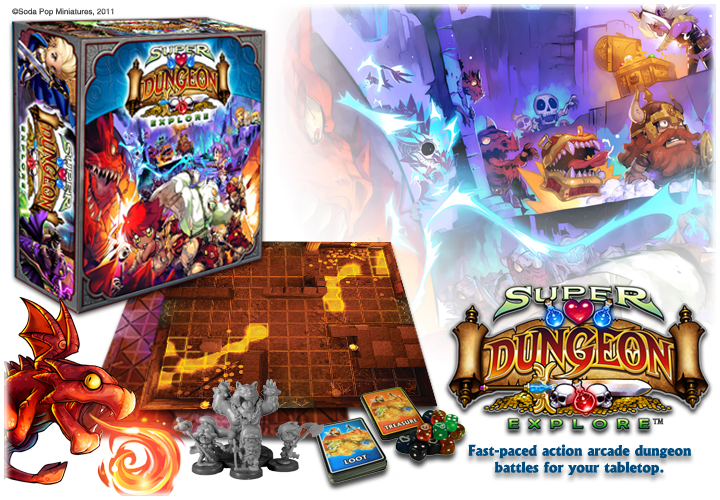 ^ Super Dungeon Explore Of course I see no reason this game couldn't be played using miniatures from another game, it wouldn't be hard to match the Heroes from this game with existing miniatures from any number of sources. The 'Ugly Snouts' of course can be represented by nearly any Orc miniatures but I feel OtherWorld's Pig-Faced Orcs would be a most appropriate (if rather expensive) choice. 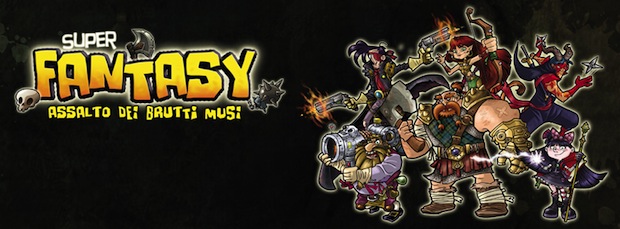 New mechanics however are always interesting to me because I'm constantly looking for new things I can incorporate into my own rules. The 'charging spells' mechanic seem quite interesting and it sounds like it would fairly easy to incorporate into HeroQuest by using the 'black shields' on the HQ combat dice in the same way as the stars on the Super Fantasy dice. I'd be interested to know how many Sword, 2 Swords and Stars symbols appear on each dice. The dice rather remind me of the ones included in the D&D Adventure Board-Game and it sounds like the basic 'to hit' mechanic of SF works in much the same way, however the combined 'dice as action points' mechanic gives this game a whole new dynamic - over all the mechanics rather reminds me of the way the dice work in Elder Sign and Arkham Horror, but crossed with Space Hulk in a strange but certainly effective way. The turn tracker/timer reminds me of DragonStrike but again this game add just a little twist to a basic mechanic to make it unique - moving the timer an extra space when a hero gets knocked out certainly add tension to the game and of course keeping the hero in the game and the player playing make the game a lot more friendly to play than the typical 'you're dead it's game-over for you' way of doing things. This sort of thing could be easily added to DragonStrike or any other game with a timer mechanic for that matter. The spawning points of course bring to mind the recently trilogy D&D dungeon crawlers (Castle Ravenloft, Wrath of Ashardalon and The Legend of Drizzt) and although I see why they've done the Fate Dice based mechanic for spawning monsters, I can't help but think a card-based mechanic might have worked better for the varying monster stats of SF. 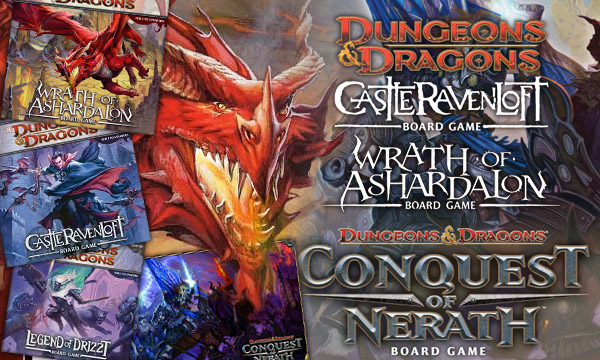 ^ Apparently there's a 4th one now too Having now read about the way Super Fantasy plays, I'd say the reason solo-play has added difficulty is probably to counter-act the habit of solo-players going easy on themselves when it comes to the monster's turn. As with most of these corporative games I don't consider AI rules to be a selling point and house-ruling in some optional GM rules would go a long way towards making the monster more challenging. Poor translation might kill this game for a lot of people, but I'd like to see what Marco would make of the original Italian version should he come across it.
-----------------------------------
~The ravings of a single mad Goblin is bad enough, but such a power-hungry, malice-filled creature as Mortis can never hope to be understood~ |
|
You are quite welcome for the review. I want to try writing more, specifically for the game store where I work. This was my first.
Super Dungeon Explore is one of my favorite games. It is a very different game than Super Fantasy, however. In Super Dungeon Explore, the heroes are working together to fight The Consul, one player who controls all the monsters in the dungeon. The Consul can spawn monsters from spawn points, which the heroes can try to destroy throughout the game, which in turn will eventually summon the Boss. It also has PVP Arena rules, where each player has a hero and a warband (from a spawn point) and fight to destroy the opposing warbands. The only thing that is similar in Super Fantasy is the concept of points where monsters spawn, however they are permanent fixtures in Super Fantasy. *NOTE* It's worth noting that Super Dungeon Explore is getting a new core set, The Forgotten King. It's on Kickstarter now. It will update the game with new rules allowing for faster play and more depth, as well as an "arcade" deck which will allow for solo/co-op play, and I couldn't be more excited for it! Speaking of using mini's, I have plenty of D&D and Pathfinder goblins that should work just fine for the Snouts. And it has me tempted to make new character boards featuring D&D characters, maybe those from the Adventure System games. The dice are essentially d3s, with two of each symbol. This is nice because you know each die is at least one success. I think this game missed out on a lot of opportunities, but I think the game play is certainly worth checking out, particularly for dungeon crawl fans looking for something new with a classic feel. However, if you are like me and have plenty of Dungeon Tiles and minis laying around, you could probably concoct something similar on your own, which would be interesting to see. Just a note on your picture of the D&D Adventure System games (which are my favorite solo games); Conquest of Nerath is (sadly) not a 4th game in the series. It is a RISK style game, with several D&D flavored twists. Worth checking out if you want a fantasy themed area control game. |
Re: New dungeon crawl board game: Super Fantasy: Ugly Snouts Assault
|
Administrator
|
Excellent you're reviews will always be most welcome here - I've added a header image to your first post to make sure people see the review below  Fair enough - SDE sounds more like it plays more like MageKnight Dungeons now that I've had it explained to me That'd be something cool to have posted here 
-----------------------------------
~The ravings of a single mad Goblin is bad enough, but such a power-hungry, malice-filled creature as Mortis can never hope to be understood~ |
Re: New dungeon crawl board game: Super Fantasy: Ugly Snouts Assault
|
I just finished the french translation of the game and played my first game on saturday night with a friendly player group who wanted to test something "new".
It's true there are some errors in the british english rulebook for the international edition but you can easily understand how it works. The restock of the game is on with some corrections by the way. The italian distributor RED GLOVES is going to release another game 100% compatible & independant with undead monsters this time called "SUPER FANTASY NIGHT OF THE BADLY DEAD". It will be presented in Essen. May be some new rules & 3 D elements to add to the ugly snouts assault. More news soon !
www.lessouterrainsoublies.fr
|
«
Return to Other Fantasy
|
1 view|%1 views
| Free forum by Nabble | Edit this page |

